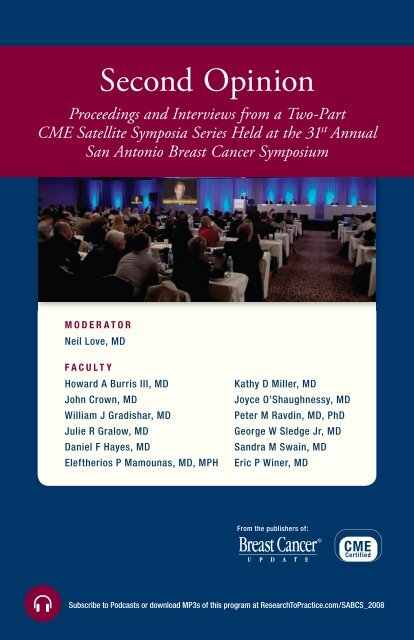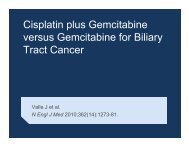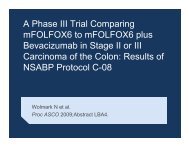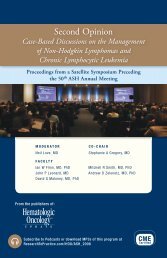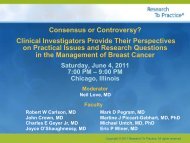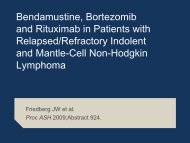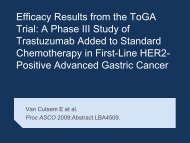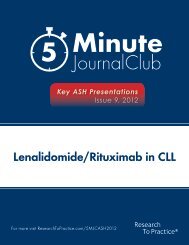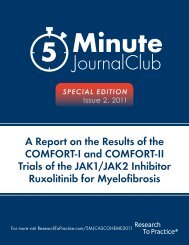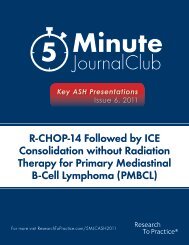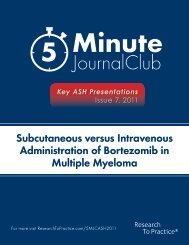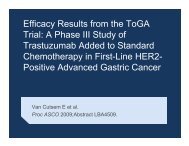Second Opinion
Second Opinion - Research To Practice
Second Opinion - Research To Practice
- No tags were found...
Create successful ePaper yourself
Turn your PDF publications into a flip-book with our unique Google optimized e-Paper software.
<strong>Second</strong> <strong>Opinion</strong>Proceedings and Interviews from a Two-PartCME Satellite Symposia Series Held at the 31 st AnnualSan Antonio Breast Cancer SymposiumM O D E R A T O RNeil Love, MDF A C U L T YHoward A Burris III, MDJohn Crown, MDWilliam J Gradishar, MDJulie R Gralow, MDDaniel F Hayes, MDEleftherios P Mamounas, MD, MPHKathy D Miller, MDJoyce O’Shaughnessy, MDPeter M Ravdin, MD, PhDGeorge W Sledge Jr, MDSandra M Swain, MDEric P Winer, MDFrom the publishers of:Subscribe to Podcasts or download MP3s of this program at ResearchToPractice.com/SABCS_2008
<strong>Second</strong> <strong>Opinion</strong>A Continuing Medical Education ProgramO V E R V I E W O F A C T I V I T YBreast cancer is one of the most rapidly evolving fields in medical oncology. Results from numerous ongoing trials lead tothe continual emergence of new therapeutic agents, treatment strategies and diagnostic/prognostic tools. To bridge thegap between research and patient care, these proceedings and interviews from a two-part CME satellite symposia seriesheld at the 31 st annual San Antonio Breast Cancer Symposium utilize the perspectives of clinical investigators, in additionto the interactive exchange between these individuals, to apply evidence-based concepts to routine practice. By providingaccess to the latest research developments and expert opinions on the disease, this activity will assist medical oncologists,hematologists and hematology-oncology fellows in the formulation of up-to-date clinical management strategies for thetreatment of breast cancer.L E A R N I N G O B J E C T I V E S• Use currently available tissue-based genomic assays and biomarkers to assist with the selection of appropriatetreatment for early breast cancer.• Develop an evidence-based algorithm for the initial treatment of postmenopausal patients with localizedER/PR-positive breast cancer.• Outline the existing data and emerging research on the optimal duration and sequence of endocrine therapy.• Communicate the benefits and risks of trastuzumab-containing regimens to patients with HER2-positive earlybreast cancer.• Recognize the acute and chronic side effects that accompany the use of adjuvant systemic therapy, and identifystrategies to address them.• Delineate the clinical evidence supporting the individualized front-line use of anti-angiogenesis therapy for locallyadvanced or metastatic breast cancer.• Construct a rational treatment algorithm integrating anti-HER2 therapy for HER2-positive recurrent orde novo metastatic breast cancer.• Compare and contrast the efficacy, safety and tolerability of taxanes commonly used in the treatment of breastcancer.• Recognize the physical and emotional challenges that accompany the diagnosis and treatment of metastaticbreast cancer.• Counsel appropriately selected patients about the availability of ongoing clinical trial participation.A C C R E D I T A T I O N S T A T E M E N TResearch To Practice is accredited by the Accreditation Council for Continuing Medical Education to provide continuingmedical education for physicians.C R E D I T D E S I G N A T I O N S T A T E M E N TResearch To Practice designates this educational activity for a maximum of 5.25 AMA PRA Category 1 Credits. Physiciansshould only claim credit commensurate with the extent of their participation in the activity.H O W T O U S E T H I S C M E A C T I V I T YThis CME activity contains both audio and print components. To receive credit, the participant should review the CMEinformation, listen to the CDs and complete the Post-test and Educational Assessment and Credit Form located in theback of this monograph or on our website at ResearchToPractice.com/SABCS_2008. This monograph contains editedcomments, clinical trial schemas, graphics and references that supplement the audio program. ResearchToPractice.com/SABCS_ 2008 includes an easy-to-use, interactive version of this monograph with links to relevant full-textarticles, abstracts, trial information and other web resources indicated here in blue underlined text.This program is supported by educational grants from Abraxis BioScience, AstraZeneca Pharmaceuticals LP,Genentech BioOncology and Genomic Health Inc.Last review date: April 2009; Release date: April 2009; Expiration date: April 2010
<strong>Second</strong> <strong>Opinion</strong>: Proceedings from a Two-Part CME Satellite Symposia SeriesHeld at the 31 st Annual San Antonio Breast Cancer Symposium and Interviewswith the Faculty — December 12-13, 2008T A B L E O F C O N T E N T SManagement of Metastatic Breast Cancer3 A 38-year-old premenopausalwoman with a 2-cm, Grade III,ER/PR-positive, HER2-positiveinfiltrating ductal carcinoma (IDC)and a 1.8-cm, biopsy-confirmedhepatic metastasis (from the practiceof Abraham B Schwarzberg, MD)6 A 65-year-old woman with rapidlyprogressive, symptomatic bone andlung metastases during her fifth yearof an adjuvant aromatase inhibitor foran ER/PR-positive, HER2-negative IDC(from the practice of Lowell L Hart, MD)8 A 47-year-old postmenopausalwoman with a 1.8-cm, ER/PRpositive,HER2-negative, nodenegativeIDC who developed bonemetastases after four years of anadjuvant aromatase inhibitor (fromthe practice of Steven P Kanner, MD)Additional Cases on the Audio ProgramA 49-year-old woman with biopsyconfirmedliver and lung metastasesthree years after adjuvant AC for atriple-negative IDC (from the practiceof Michael A Schwartz, MD)A 47-year-old woman who developedmultiple unresectable brain metastaseseight years after adjuvantanthracycline/taxane therapy foran ER/PR-negative, HER2-positiveIDC (from the practice ofKenneth R Hoffman, MD, MPH)A 62-year-old woman with aneglected 6-cm, ER/PR-positive,HER2-positive IDC and biopsyprovenlung metastases (from thepractice of Dr Hoffman)Adjuvant Therapy for Early Breast Cancer10 A 76-year-old woman with a 0.8-cm,ER/PR-positive, HER2-negative,moderately differentiated IDC with twopositive nodes and an Oncotype DX ®Recurrence Score ® of 13 (from thepractice of Samuel N Bobrow, MD)13 A 76-year-old woman who underwenta mastectomy for a 6-cm, ER/PR-positive, HER2-positive, T4b IDCwith skin ulceration and extensivedermal involvement (from the practiceof Isaac Levy, MD)15 A 37-year-old woman with a 0.4-cm,moderately differentiated, ER/PR-negative, HER2-positive, nodenegativeIDC (from the practiceof Dr Bobrow)Additional Cases on the Audio ProgramA 41-year-old woman with longstandingType 1 diabetes who underwentrecent laser therapy for retinopathyand is diagnosed with a 1.8-cm,triple-negative, node-negative IDC(from the practice of Dr Hoffman)A 67-year-old woman with a 2.5-cm,ER/PR-positive, HER2-negative,node-negative IDC who has completedfive years of adjuvant anastrozole(from the practice of Dr Hoffman)A 56-year-old premenopausal womanwith a 2.2-cm, ER/PR-positive,HER2-negative, node-negative IDCwith 88 percent Ki-67 (from thepractice of Dr Hart)18 POST-TEST19 EDUCATIONAL ASSESSMENT AND CREDIT FORM
C O N TENT VA LIDATION A ND D IS C LOSURE SResearch To Practice (RTP) is committed to providing its participants with high-quality, unbiased andstate-of-the-art education. We assess potential conflicts of interest with faculty, planners and managersof CME activities. Real or apparent conflicts of interest are identified and resolved through a conflict ofinterest resolution process. In addition, all activity content is reviewed by both a member of the RTPscientific staff and an external, independent physician reviewer for fair balance, scientific objectivity ofstudies referenced and patient care recommendations.FACULTY — Dr Winer had no real or apparent conflicts of interest to disclose. The following faculty(and their spouses/partners) reported real or apparent conflicts of interest, which have been resolvedthrough a conflict of interest resolution process: Dr Burris — Consulting Agreements: Bristol-Myers Squibb Company, Celgene Corporation, Genentech BioOncology, GlaxoSmithKline, ImCloneSystems Incorporated, Novartis Pharmaceuticals Corporation, Roche Laboratories Inc, Sanofi-Aventis.Prof Crown — Speakers Bureau: GlaxoSmithKline, Pfizer Inc, Sanofi-Aventis. Dr Gradishar — AdvisoryCommittee: Abraxis BioScience, AstraZeneca Pharmaceuticals LP, Bristol-Myers Squibb Company,Eisai Inc, Genentech BioOncology, GlaxoSmithKline, Novartis Pharmaceuticals Corporation, Pfizer Inc;Consulting Agreements: Abraxis BioScience, Amgen Inc, AstraZeneca Pharmaceuticals LP, Bristol-Myers Squibb Company, Eisai Inc, Genentech BioOncology, GlaxoSmithKline, Novartis PharmaceuticalsCorporation, Pfizer Inc. Dr Gralow — Consulting Agreements: Amgen Inc, Genentech BioOncology,Genomic Health Inc, GlaxoSmithKline, Novartis Pharmaceuticals Corporation, Roche LaboratoriesInc, Sanofi-Aventis. Dr Hayes — Paid Research: AstraZeneca Pharmaceuticals LP, GlaxoSmithKline,Novartis Pharmaceuticals Corporation, Pfizer Inc. Dr Mamounas — Advisory Committee: AbraxisBioScience, Bayer Pharmaceuticals Corporation, Bristol-Myers Squibb Company, Eli Lilly andCompany, Genentech BioOncology, Genomic Health Inc, GlaxoSmithKline, Novartis PharmaceuticalsCorporation, Pfizer Inc, Sanofi-Aventis; Consulting Agreement: Roche Laboratories Inc; SpeakersBureau: Eli Lilly and Company, Genentech BioOncology, Genomic Health Inc, Pfizer Inc, Sanofi-Aventis. Dr Miller — Consulting Agreements: Eli Lilly and Company, Genentech BioOncology, RocheLaboratories Inc; Paid Research: Pfizer Inc, Roche Laboratories Inc; Speakers Bureau: GenentechBioOncology, Roche Laboratories Inc. Dr O’Shaughnessy — Consulting Agreements: Biogen Idec,GlaxoSmithKline; Speakers Bureau: Abraxis BioScience, AstraZeneca Pharmaceuticals LP, Bristol-Myers Squibb Company, Eli Lilly and Company, Sanofi-Aventis. Dr Ravdin — Consulting Agreement:Genomic Health Inc; Speakers Bureau: AstraZeneca Pharmaceuticals LP; Stock Ownership:Adjuvant! Inc, Bristol-Myers Squibb Company, Pfizer Inc, Wyeth. Dr Sledge — Advisory Committee:Genentech BioOncology, GlaxoSmithKline, Novartis Pharmaceuticals Corporation; ConsultingAgreement: Genentech BioOncology; Paid Research: Eli Lilly and Company, Sanofi-Aventis. Dr Swain— Foundation Grant: Genentech BioOncology; Paid Research: Bristol-Myers Squibb Company; PaidTravel: Sanofi-Aventis.MODERATOR — Neil Love: Dr Love is president and CEO of Research To Practice, which receivesfunds in the form of educational grants to develop CME activities from the following commercialinterests: Abraxis BioScience, AstraZeneca Pharmaceuticals LP, Aureon Laboratories Inc, BayerPharmaceuticals Corporation/Onyx Pharmaceuticals Inc, Biogen Idec, Bristol-Myers Squibb Company,Celgene Corporation, Cephalon Inc, Eisai Inc, Eli Lilly and Company, Genentech BioOncology, GenomicHealth Inc, Genzyme Corporation, GlaxoSmithKline, ImClone Systems Incorporated, Merck andCompany Inc, Millennium Pharmaceuticals Inc, Novartis Pharmaceuticals Corporation, Ortho BiotechProducts LP, OSI Oncology, Pfizer Inc, Roche Laboratories Inc, Sanofi-Aventis, Synta PharmaceuticalsCorp and Wyeth.RESEARCH TO PRACTICE STAFF AND EXTERNAL REVIEWERS — The scientific staff and reviewersfor Research To Practice have no real or apparent conflicts of interest to disclose.This educational activity contains discussion of published and/or investigational uses of agents that arenot indicated by the Food and Drug Administration. Research To Practice does not recommend the useof any agent outside of the labeled indications. Please refer to the official prescribing information for eachproduct for discussion of approved indications, contraindications and warnings. The opinions expressedare those of the presenters and are not to be construed as those of the publisher or grantors.If you would like to discontinue your complimentary subscription to Breast Cancer Update, pleaseemail us at Info@ResearchToPractice.com, call us at (800) 648-8654 or fax us at (305) 377-9998.Please include your full name and address, and we will remove you from the mailing list.2
MANAGEMENT OF METASTATIC BREAST CANCERFrom the practice of Abraham B Schwarzberg, MDA 38-year-old premenopausal woman was diagnosed with a 2-cm, Grade III, ER/PRpositive,HER2-positive IDC. CT scan revealed a 1.8-cm nodule in the left lobe of theliver, and biopsy confirmed metastatic disease. The remainder of this patient’s workupwas negative.Select Excerpts from the DiscussionTrack 37DR LOVE: Kathy, what’s your approach to treating patients presentingwith asymptomatic metastatic breast cancer?DR MILLER: I have several patients in my practice who presented withmetastatic disease at the time of initial diagnosis. In the long-term follow-upseries from MD Anderson, a small group of patients were potentially cured,or were at least long-term survivors, of their metastatic disease. These womenwere predominantly treated with anthracycline-based chemotherapy, along withhormonal therapy if appropriate. We do not know how to identify these women,but they did not have multiple, bulky sites of symptomatic disease or less than acomplete response to systemic therapy.I tell patients that in general, metastatic disease is not curable but that Ihave seen exceptions. Among younger women with limited, asymptomaticmetastatic breast cancer, it is reasonable to assume that a few will be long-termsurvivors. A key component is to achieve a complete response to the initialsystemic therapy, so I would begin with an aggressive treatment plan. Theremainder of our decisions will follow from how well she responds to the initialtherapy.For this patient with HER2-positive disease, I would consider the TCHregimen. She also would be eligible for the ECOG-E1105 study, whichrandomly assigns patients to paclitaxel/trastuzumab and optional carboplatinwith or without bevacizumab. I have a patient enrolled on E1105 who is similarto this 38-year-old woman. If she demonstrates a complete response to chemotherapy,we will proceed to local therapy for her primary tumor and continuedtherapy with trastuzumab and hormonal therapy.If she doesn’t experience a complete response, then the best data suggestthat she doesn’t have the possibility of long-term survival and we need to shiftour goals to preserving the quality of her life while still trying to extend thequantity of her life. So we would perhaps make different decisions about localtherapy, about the use of more aggressive hormone therapy and about how longwe might continue the trastuzumab.3
Track 21DR LOVE: Dan, how would you approach treating this patient?DR HAYES: A number of philosophical approaches to this patient are available.One is to acknowledge that she has metastases, and the treatment is palliation.Therefore, one should choose the treatment most likely to be effective withthe fewest side effects. I tell patients, “The bad news is that you have metastaticbreast cancer, and we will probably not cure you. The good news is that wehave many therapeutic options.” Many of those options are interchangeable, sodefining a treatment plan entails working with the patient and the family to findout what’s best for the individual.This patient has ER/PR-positive, HER2-positive disease, and I would probablyinitiate treatment with endocrine therapy. It would be reasonable to start her ontamoxifen. One could also argue in favor of tamoxifen with trastuzumab, butthat would require her to come to the clinic every three weeks for intravenoustherapy. Others might opt for ovarian ablation in combination with tamoxifen,which results in a higher response rate but no improvement in survival.DR LOVE: What about chemotherapy and trastuzumab?DR HAYES: This woman is in no danger of dying of her disease in the nexttwo months or of developing substantial end-organ dysfunction that wouldprohibit the administration of chemotherapy and trastuzumab down the road. Isee no evidence that she would live longer by receiving up-front chemotherapy/trastuzumab, but she would be subjected to toxicities that could be avoided forthe time being. If an oncologist wanted to use chemotherapy/trastuzumab, Iwouldn’t argue strongly against it, but it’s not what I would do.Track 3DR LOVE: One of the most discussed issues in the management of HER2-positive metastatic breast cancer is continuation of trastuzumab or otheranti-HER2 therapy on disease progression. Joyce, what are your thoughts?DR O’SHAUGHNESSY: Some of the most important data from ASCO last yearaddressed the question, does continuing trastuzumab beyond disease progressionprovide a clinical benefit? I had the opportunity to present data from a Phase IIItrial for patients with HER2-positive metastatic breast cancer who were heavilypretreated with an anthracycline, a taxane and trastuzumab (O’Shaughnessy2008; [1.1]). Approximately one third of the patients had received six or moreregimens for metastatic disease.Upon disease progression, patients were randomly assigned to lapatinib at 1,500milligrams or lapatinib at 1,000 milligrams in combination with weekly trastuzumab.The hazard ratio for progression-free survival, which was the primaryendpoint, was 0.73, so the combination was clearly superior to switching to adifferent HER2-targeted therapy, single-agent lapatinib.4
In another trial addressing this question, patients with HER2-positive metastaticbreast cancer that had progressed through one line of trastuzumab-based therapywere randomly assigned to capecitabine with or without trastuzumab (vonMinckwitz 2008; [1.2]).The combination yielded nearly double the objective response rate, a 50 percentimprovement in the clinical benefit rate, a significant improvement in progression-freesurvival and a trend for improvement in overall survival. So this trialfavored continuation of trastuzumab and simply switching the chemotherapyupon disease progression.DR WINER: The von Minckwitz study probably underestimated the benefitof continuing trastuzumab because the women who received capecitabinemonotherapy still had trastuzumab in their system (von Minckwitz 2008). Thatstudy, along with Joyce’s data with the combination of lapatinib and trastuzumab(O’Shaughnessy 2008), confirm that, at least for some patients, a role does existfor continuing trastuzumab after disease progression.1.1Lapatinib (L) with or without Trastuzumab (T) for HeavilyPretreated Patients with Metastatic Breast Cancer ExperiencingDisease Progression on Trastuzumab TherapyLL + TParameter (n = 145) (n = 146) Odds ratio p-valueResponse rate 1 6.9% 10.3% 1.5 0.46Clinical benefit rate 2 12.4% 24.7% 2.2 0.01Hazard ratiop-valueMedian PFS 8.1 weeks 12.0 weeks 0.73 0.008Median overall survival 3 39.0 weeks 51.6 weeks 0.75 0.1061Confirmed complete responses (CR) + partial responses (PR); 2 CR + PR + stable disease ≥6 months; 3 Intent-to-treat population; PFS = progression-free survival; Odds ratio > 1, hazardratio < 1 favors L + TSOURCE: O’Shaughnessy J et al. Proc ASCO 2008;Abstract 1015.1.2Phase III Study of Capecitabine (X) versus Capecitabine/Trastuzumab(XH) for Patients with HER2-Positive Metastatic Breast CancerProgressing During Trastuzumab TherapyEndpoint X (n = 78) XH (n = 78) p-valueTime to progression 5.6 months 8.2 months 0.03Overall survival 20.4 months 25.5 months Nonsignificant trendResponse rate 27% 48% 0.01Clinical benefit rate 54.0% 75.3% 0.007SOURCE: Von Minckwitz G et al. Proc ASCO 2008;Abstract 1025.5
SELECT PUBLICATIONSDawood SS et al. Prognosis of women with stage IV breast cancer by HER2 status andtrastuzumab treatment: An institutional based review. Proc ASCO 2008;Abstract 1018.O’Shaughnessy J et al. A randomized study of lapatinib alone or in combination withtrastuzumab in heavily pretreated HER2+ metastatic breast cancer progressing ontrastuzumab therapy. Proc ASCO 2008;Abstract 1015.Von Minckwitz G et al. Capecitabine vs capecitabine + trastuzumab in patients withHER2-positive metastatic breast cancer progressing during trastuzumab treatment:The TBP phase III study (GBG 26/BIG 3-05). Proc ASCO 2008;Abstract 1025.From the practice of Lowell L Hart, MDA 65-year-old woman was diagnosed with ER/PR-positive, HER2-negative, node-positivebreast cancer and was treated with FEC 100 adjuvant chemotherapy followed byletrozole. During the fifth year of letrozole, the patient was diagnosed with symptomaticbone metastases and treated with fulvestrant, but the disease progressed rapidly withsymptomatic bone disease and new lung metastases with shortness of breath. The patientwas treated with single-agent nanoparticle albumin-bound (nab) paclitaxel and had anear-complete response with minimal side effects.Tracks 30, 32DR LOVE: Dan, how would you have approached treating this patient onfirst diagnosis of metastatic disease?DR HAYES: This patient’s disease may or may not be endocrine refractory. She’snever received tamoxifen, which is a good agent. However, she is developingend-organ dysfunction, and this patient doesn’t have a lot of “wiggle room.” Ifyou administer tamoxifen and two or three months later you discover that wasthe wrong choice, then you’re in trouble. Her symptoms will be much worse,which makes it even more difficult to administer chemotherapy. So I wouldprobably proceed with chemotherapy and use paclitaxel/bevacizumab.Because this patient showed a great response to nab paclitaxel, Dr Hart waswondering whether he should have administered bevacizumab or whether hecould administer it with another, second-line chemotherapy when the diseaseprogresses. I don’t believe we’re obligated to use bevacizumab with a taxane upfront. However, I would probably administer bevacizumab as first-line therapybecause we have a prospective, randomized trial suggesting that time to diseaseprogression is prolonged (Miller 2007).Track 15DR GRALOW: I probably would opt for paclitaxel and bevacizumab in this situation.It would also be reasonable to enroll this patient on the CALGB-40502trial, evaluating paclitaxel/bevacizumab versus nab paclitaxel/bevacizumabversus ixabepilone/bevacizumab (2.1).6
I’m impressed with nab paclitaxel and find it easier to administer than paclitaxel.It doesn’t require premedication, we see fewer allergic reactions and patientsprefer it. In many cases we seek insurance preauthorization and, if we obtain it,that’s my choice. If not, I choose paclitaxel.Bill Gradishar published Phase III data comparing standard paclitaxel to nabpaclitaxel for patients with metastatic breast cancer and demonstrated that ahigher dose of paclitaxel could be administered with less hematologic toxicityand an improvement in response rate and time to disease progression with nabpaclitaxel (Gradishar 2005; [2.2]).2.1Phase III Trial of Weekly Paclitaxel Compared to Weekly NabPaclitaxel or Ixabepilone Combined with Bevacizumab as First- or<strong>Second</strong>-Line Therapy for Locally Recurrent or Metastatic Breast CancerProtocol IDs: CALGB-40502, CTSU, NCT00785291; Target Accrual: 900EligibilityStage IIIB not amenable to local therapy or Stage IV breast cancer; no preexisting peripheralneuropathy ≥ Grade II; no recent history of abdominal fistula or intra-abdominal abscess, gastrointestinalperforation or significant bleeding; no clinically significant cardiovascular disease;no history of stroke or TIA within previous six months; no CNS metastasesWeekly paclitaxel + bevacizumabRWeekly nab paclitaxel + bevacizumabWeekly ixabepilone + bevacizumabSOURCE: www.clinicaltrials.gov. Accessed February 24, 2009.2.2Phase III Randomized Trial Comparing Nab Paclitaxel(Every Three Weeks) to Paclitaxel (Every Three Weeks)for Women with Metastatic Breast CancerNab paclitaxel 1 Paclitaxel 2Parameter (n = 229) (n = 225) p-valueComplete and partial responsesAll patients 33% 19% 0.001First-line therapy 42% 27% 0.029<strong>Second</strong>-line or greater therapy 27% 13% 0.006Median time to tumor progression 23.0 weeks 16.9 weeks 0.006Median survivalAll patients 65.0 weeks 55.7 weeks 0.374<strong>Second</strong>-line or greater therapy 56.4 weeks 46.7 weeks 0.0241Nab paclitaxel at 260 mg/m 2 every three weeks without premedication2Paclitaxel at 175 mg/m 2 every three weeks with premedicationSOURCE: Gradishar WJ et al. J Clin Oncol 2005;23(31):7794-803. Abstract7
A randomized Phase II trial reported at the 2007 ASCO meeting compared nabpaclitaxel every two weeks or every three weeks to docetaxel every three weeksfor patients with metastatic breast cancer and demonstrated higher response ratesfor nab paclitaxel (Gradishar 2007; [2.3]).2.3Randomized Phase II Study of Weekly or Every Three-WeekNab Paclitaxel versus Every Three-Week Docetaxel as First-LineChemotherapy for Patients with Metastatic Breast CancerNab paclitaxel Nab paclitaxelNab paclitaxel 100 mg/m 2 150 mg/m 2 Docetaxel300 mg/m 2 weekly 3 out of weekly 3 out of 100 mg/m 2q3wk 4 weeks 4 weeks q3wk(n = 76) (n = 76) (n = 74) (n = 74)Objective response rateby investigator assessment 43% 62%* 70% † 38%Grade III/IV neutropenia 44% 25% 43% 94%Grade III/IV peripheralneuropathy 17% 9% 16% 11%Grade III/IV fatigue 4% 0% 3% 19%* p-value = 0.002 versus docetaxel arm; † p-value = 0.003 versus docetaxel armSOURCE: Gradishar W et al. Proc ASCO 2007;Abstract 1032.SELECT PUBLICATIONSGradishar W et al. Randomized comparison of weekly or every-3-week (q3w) nab-paclitaxelcompared to q3w docetaxel as first-line therapy in patients (pts) with metastaticbreast cancer (MBC). Proc ASCO 2007;Abstract 1032.Gradishar WJ et al. Phase III trial of nanoparticle albumin-bound paclitaxel comparedwith polyethylated castor oil-based paclitaxel in women with breast cancer. J Clin Oncol2005;23(31):7794-803. AbstractMiller K et al. Paclitaxel plus bevacizumab versus paclitaxel alone for metastatic breastcancer. N Engl J Med 2007;357(26):2666-76. AbstractMiller KD et al. Randomized phase III trial of capecitabine compared with bevacizumabplus capecitabine in patients with previously treated metastatic breast cancer.J Clin Oncol 2005;23(4):792-9. AbstractFrom the practice of Steven P Kanner, MDA 47-year-old postmenopausal woman (s/p oophorectomy) who presented with a 1.8-cm,node-negative, ER/PR-positive, HER2-negative tumor was treated with four cycles of ACfollowed by letrozole. After four years, the surgeon following the case ordered a bone scan,which revealed bone metastases.Tracks 13-15DR GRADISHAR: I probably wouldn’t have ordered imaging studies for thispatient. However, once I knew bone disease was present, I would start endocrinetherapy in addition to a bisphosphonate. I believe that exemestane and fulves-8
trant are equivalent choices, and a case could be made for tamoxifen as well.Biopsies of bone-only metastases can be problematic because a negative resultcan be caused by a sampling error. So one can make a case for treating empiricallywith endocrine therapy. However, if the patient developed any visceral orsoft tissue disease that could be biopsied easily, I would do so.In cases such as this one treatment is palliative, not curative, so the goals ofselecting an endocrine therapy include delaying the time until chemotherapy isneeded and maintaining quality of life. In managing metastatic disease, we don’thave to see the lesions disappear. Stable disease is an acceptable endpoint, and ithas an outcome that’s equivalent to an objective response.With bone-only disease, evidence supports continuing endocrine therapy as longas you don’t observe disease progression. If the bone scan remains stable, that’sacceptable. I would use endocrine therapy to the point of exhaustion, as long asthe patient doesn’t develop a visceral crisis or another problem that motivates usto use chemotherapy.We’ve spent 20 years trying to figure out which endocrine agent or sequence isbest in these cases. The bottom line is that it probably doesn’t make a big difference.You can switch between classes of endocrine therapy, or within the classof aromatase inhibitors you can switch between a steroidal and a nonsteroidalaromatase inhibitor. In the EFECT study, fulvestrant was compared to exemestaneamong patients whose disease progressed on a nonsteroidal aromataseinhibitor, and the outcomes were identical regarding side effects, clinical benefitrate, objective response rate and time to disease progression.Additional Cases Discussing Metastatic Disease on the Audio ProgramA 49-year-old woman with biopsy-confirmed liver and lung metastases threeyears after adjuvant AC for a triple-negative IDC (from the practice ofMichael A Schwartz, MD)A 47-year-old woman who developed multiple unresectable brain metastases eightyears after adjuvant anthracycline/taxane therapy for an ER/PR-negative, HER2-positive IDC (from the practice of Kenneth R Hoffman, MD, MPH)A 62-year-old woman with a neglected 6-cm, ER/PR-positive, HER2-positive IDCand biopsy-proven lung metastases (from the practice of Dr Hoffman)SELECT PUBLICATIONSChia S et al. Double-blind, randomized placebo controlled trial of fulvestrant comparedwith exemestane after prior nonsteroidal aromatase inhibitor therapy in postmenopausalwomen with hormone receptor-positive, advanced breast cancer: Results fromEFECT. J Clin Oncol 2008;26(10):1664-70. AbstractCosta L et al. Role of bisphosphonates for the management of skeletal complicationsand bone pain from skeletal metastases. Support Cancer Ther 2006;3(3):143-53. AbstractLyseng-Williamson KA. Zoledronic acid: A review of its use in breast cancer. Drugs2008;68(18):2661-82. AbstractPecherstorfer M. Treatment options for breast cancer and bone metastases. Womens Health(Lond Engl) 2009;5(2):149-63. Abstract9
ADJUVANT THERAPY FOR EARLY BREAST CANCERFrom the practice of Samuel N Bobrow, MDA 76-year-old woman is diagnosed with a 0.8-cm, ER/PR-positive, HER2-negative,moderately differentiated IDC. Two of 15 nodes are positive, and her Oncotype DXRecurrence Score is 13. Postoperatively, the patient is treated with radiation therapyfollowed by an aromatase inhibitor.Select Excerpts from the DiscussionTracks 80-81DR LOVE: Was it reasonable to order an Oncotype DX assay for this nodepositivecase?DR SLEDGE: I believe it was reasonable. It strikes me as relatively unlikely thatthe biology of breast cancer changes dramatically during the transition fromnode-negative to one or two positive nodes, and we have evidence that suggestspatients with low Recurrence Scores are unlikely to receive much benefit fromchemotherapy.If one simply evaluates the actuarial tables, a patient, particularly an elderlypatient, may experience as much harm as benefit from chemotherapy. For thispatient, I might consider hormonal therapy as my baseline.When the Recurrence Score is high, although we don’t have Oncotype DXdata with breakdowns by age, some healthy, older women with no comorbiditieshave sufficiently aggressive cancer and one might expect them to receive abenefit from chemotherapy.DR LOVE: What did you think about the Oncotype DX data from the Trans-ATAC analysis presented by Mitch Dowsett?DR SLEDGE: They examined a fairly large subset of the ATAC trial populationto determine the Recurrence Score for each case, and, as we have seen inessentially every other data set, patients with low Recurrence Scores fared well(Dowsett 2008; [3.1]). In fact, 96 percent of patients with node-negative tumorsand low Recurrence Scores were free of distant recurrences at nine years.In addition, a number of patients in the subset had node-positive disease.Although the data were confirmatory, Dowsett was careful to say that thenumbers were smaller and, therefore, the data were less solid.My bias is that the consistency across all of the studies with Oncotype DXsuggests that biology trumps anatomy in many cases. Although anatomy addsprognostic data, I suspect that from a predictive standpoint, Oncotype DX islikely to provide us with a great majority of our relevant data.10
3.1TransATAC: Proportion of Patients Treated with Anastrozole or TamoxifenWho Are Free of Distant Recurrence at Nine Years by Oncotype DXRecurrence Score Group: Analysis of Nodal StatusLow Int. High High vs low Int. vs lowNode-negative(n = 513, 229, 130) 96% 88% 75% HR* = 5.2 HR* = 2.5Node-positive(n = 160, 94, 52) 83% 72% 51% HR* = 2.7 HR* = 1.8* HR = hazard ratio for Recurrence Score group, adjusted for tumor size, grade, age and treatmentSOURCE: Dowsett M et al. Presentation. San Antonio Breast Cancer Symposium 2008;Abstract 53.Track 84DR LOVE: Dr Bobrow selected an aromatase inhibitor for this patient.Would you comment on Dr Ingle’s meta-analysis of aromatase inhibitorsversus tamoxifen?DR SLEDGE: The meta-analysis was incomplete because it left out the BIG1-98 sequencing arms. However, it suggested that aromatase inhibitors aresuperior to tamoxifen in terms of preventing breast cancer recurrence.The first portion of the analysis evaluated the head-to-head, five-year randomizationsof aromatase inhibitors versus tamoxifen. With a median follow-up ofeight years, a nearly four percent absolute improvement in recurrence rate wasseen with aromatase inhibitors (Ingle 2008). That is convincing enough for meto consider an aromatase inhibitor up front for most cases.The second portion compared continued tamoxifen to switching to an aromataseinhibitor after two to three years. It too showed that women who cross overto an aromatase inhibitor always fare better, and an overall survival advantagewas evident when switching to an aromatase inhibitor.Track 95DR LOVE: What are your thoughts about Cuzick’s paper demonstratingthat patients on the ATAC trial who experienced vasomotor symptomsor arthralgias experienced significantly fewer recurrences, regardless ofwhether they received tamoxifen or an aromatase inhibitor (Cuzick 2008;[3.2])?DR O’SHAUGHNESSY: I believe it’s a consideration, so when patients tell methey are having vasomotor symptoms or stiffness, I say, “Good. Great. Let’s prayfor hot flashes.”I especially like to hear of symptoms in patients taking tamoxifen who are alsotaking antidepressants. Tamoxifen is converted by CYP2D6, and endoxifen is11
its most active and plentiful metabolite. Antidepressants can inhibit CYP2D6 invarying degrees, so I like to hear that these patients have vasomotor symptoms.In terms of the arthralgias, I believe we need more insight into some of thepolymorphisms of the aromatase enzyme. It’s highly polymorphic, and I need tosee a paper showing a correlation between the arthralgias, polymorphisms andestradiol levels. I believe we will see that.DR LOVE: Does that mean you prefer to keep a symptomatic patient on anaromatase inhibitor if the side effects are tolerable?DR O’SHAUGHNESSY: Yes. Now, having read this paper, I would prefer formy patients to have some side effects. I worry a little about the asymptomaticpatients. However, most women will tell you that they’re at least stiff when theyget up to walk. I would estimate that two thirds of the women receiving anaromatase inhibitor experience musculoskeletal symptoms.3.2ATAC Trial: Annual Breast Cancer Recurrence Rate According toEndocrine Symptoms Reported at Three-Month Follow-UpAnastrozole Tamoxifen Overall Hazard ratio*(n = 1,967) (n = 1,997) (n = 3,964) (95% CI) p-valueVasomotorsymptoms 1.7% 2.4% 2.1% 0.84 (0.71-1.00) 0.04Joint symptoms 1.6% 1.9% 1.7% 0.60 (0.5-0.72)
From the practice of Isaac Levy, MDA 76-year-old woman underwent a modified mastectomy for a 6-cm, Grade III, ER/PR-positive, HER2-positive IDC. The tumor was staged as T4b with extensive dermalinvolvement. She received TCH, but during her sixth cycle she developed an intraabdominalabscess secondary to a perforated diverticulum, and treatment was stopped.She ultimately required a colon resection and then underwent closure of a divertingileostomy. She is now back to baseline but has been off therapy for six months.Track 57DR LOVE: Dr Levy questions whether to restart trastuzumab. Terry, whatdo we know about delayed trastuzumab?DR MAMOUNAS: We don’t have many data in this particular setting. We knowthat when chemotherapy is delayed, the benefit is decreased. I would havepreferred to restart trastuzumab once she recovered from the perforated diverticulitis,maybe within a couple of months of her last dose.We’re in uncharted territory at this point, but I believe it is logical to administertrastuzumab. In the HERA trial, sequential trastuzumab administered afterchemotherapy was still effective. I would administer trastuzumab to this patientfor at least another six months or so.DR SWAIN: I agree that we don’t have a lot of data, but we do know thattrastuzumab stays around a long time. The five half-lives from the five doses shedid receive gave her another several months of therapy. I also agree that I wouldhave administered the trastuzumab earlier, if the patient had agreed to it.Tracks 58-59DR LOVE: What about the idea of neoadjuvant trastuzumab for thispatient?DR SWAIN: I absolutely would have recommended it for this patient with a T4btumor and skin involvement. Aman Buzdar published data from a randomizedstudy for patients with operable, early HER2-positive breast cancer who receivedan epirubicin-based regimen with or without trastuzumab (Buzdar 2005).The patients who received trastuzumab had a pathologic complete response(pCR) rate of 65 percent, demonstrating a significant benefit with neoadjuvanttrastuzumab.At the 2008 San Antonio Breast Cancer Symposium, Dr Gianni presented anupdate of the NOAH trial, which randomly assigned more than 200 patientswith locally advanced, HER2-positive breast cancer to receive an anthracyclinebasedregimen with or without trastuzumab (Gianni 2008). The pCR rate was43 percent compared to 23 percent, respectively, so it was clearly beneficial toreceive trastuzumab (4.1).13
DR LOVE: Dan, in Dr Buzdar’s study and the NOAH trial, trastuzumab wasadministered concurrently with an anthracycline. Why didn’t they see increasedcardiac toxicity with the combination in either trial?DR HAYES: I spoke with Luca after his presentation and asked him thatquestion. His answer was twofold. First, in the metastatic setting, where we haveseen cardiac toxicity, the patients had already received a substantial amount ofadjuvant doxorubicin.<strong>Second</strong>, he felt that data from clinical trials in which heart failure was carefullymonitored prospectively, as opposed to retrospectively, were probably moreaccurate. Based on Buzdar’s and Gianni’s studies, it appears that administeringconcurrent anthracycline and trastuzumab may be safe, although I still swallowhard when I say that because I’ve been trained to believe otherwise.DR MAMOUNAS: The Buzdar neoadjuvant approach is not standard, but clinicianshave adopted it to some extent and we have used it a couple of times inour center with good results.With regard to the low rate of cardiac dysfunction seen in these trials, theBuzdar study used 75 mg/m 2 of epirubicin for four cycles, which is less than wetraditionally use. In Luca’s trial, patients received only three cycles of doxorubicin/paclitaxel,rather than the customary four cycles. It would appear that ifwe minimize exposure to the anthracycline, we might get away with concurrenttrastuzumab.4.1Neoadjuvant Chemotherapy with Trastuzumab in Patients with LocallyAdvanced, HER2-Positive Breast Cancer: Primary Efficacy DataPathologic complete response rate for primary tumors: Intent-to-treat populationChemotherapy +trastuzumab Chemotherapy p-valueHER2-positive tumors 43% 23% 0.002Chemotherapy + trastuzumab versus chemotherapyProbability HR 95% CI p-valueEvent-free survival 0.56 0.36-0.85 0.006*Overall survival 0.65 0.34-1.23 0.18* Unadjusted for stratification variables: Adjusted HR = 0.55, p = 0.0062SOURCE: Gianni L et al. Presentation. San Antonio Breast Cancer Symposium 2008;Abstract 31.SELECT PUBLICATIONSBuzdar AU et al. Significantly higher pathologic complete remission rate after neoadjuvanttherapy with trastuzumab, paclitaxel, and epirubicin chemotherapy: Resultsof a randomized trial in human epidermal growth factor receptor 2-positive operablebreast cancer. J Clin Oncol 2005;23(16):3676-85. AbstractGianni L et al. Neoadjuvant trastuzumab in patients with HER2-positive locallyadvanced breast cancer: Primary efficacy analysis of the NOAH trial. Presentation. SanAntonio Breast Cancer Symposium 2008;Abstract 31.14
From the practice of Samuel N Bobrow, MDA 37-year-old woman is diagnosed with a 0.4-cm, moderately differentiated IDC. Thetumor is ER/PR-negative and HER2-positive by FISH.Track 73DR LOVE: How do you think this patient should be treated?PROF CROWN: I would find it difficult to justify the use of adjuvant trastuzumabfor a patient with a tumor smaller than five millimeters. In fact, althoughI’m in the minority on this, I would not recommend any systemic therapy forthis patient outside of a clinical trial.I believe many people would recommend the TCH regimen for this patient. It hasa manageable side-effect profile. In our BCIRG 006 trial, we’ve seen a small riskof leukemia for the anthracycline-containing arms and none as yet with TCH.Also, the rate of cardiac failure is four out of 1,000 patients and the cardiactoxicity associated with trastuzumab appears to improve with time in most cases,which suggests that the qualitative nature of the trastuzumab cardiac lesion isdifferent from that seen with an anthracycline.DR LOVE: Would you consider using trastuzumab alone?PROF CROWN: We have no data in the adjuvant setting for trastuzumabmonotherapy. I believe a good rule is that if a patient satisfies a practitioner’scriteria for offering adjuvant chemotherapy and has HER2-positive disease,trastuzumab should be administered.Track 87DR LOVE: George, how would you approach treatment for this patient?DR SLEDGE: First, I would tell the patient that we have no data with tumorsthis small but that the data we do have across a variety of sizes and nodalstatuses show us that trastuzumab is beneficial. Her risk of recurrence may beless because the tumor is small, but when a patient tells you she wants no stoneunturned, then you have your answer.I probably would not recommend anthracycline-based chemotherapy because ofthe frightening possibility of turning this young woman into a cardiac cripple.Rather, I would use a regimen such as TCH. I’m also comfortable with thisregimen for patients with larger tumors and positive nodes, up to a point.DR LOVE: When was the last time you used an anthracycline as treatment for aHER2-positive tumor?DR SLEDGE: It’s probably been 18 months or so, but I must add that I alsohaven’t seen many patients with early breast cancer and 13 positive nodes.15
Tracks 98-99DR LOVE: Joyce, what would be your treatment approach?DR O’SHAUGHNESSY: I would enroll her on our Phase II trial in which patientsreceive four cycles of docetaxel/cyclophosphamide in combination with weeklytrastuzumab, followed by trastuzumab every three weeks to complete one yearof therapy. Preliminary toxicity data from this trial was presented at the SanAntonio meeting in 2008 (Jones 2008). Outside of a trial, I would use SteveJones’s TC with trastuzumab regimen.DR LOVE: How do you estimate this patient’s risk of recurrence with such asmall tumor?DR O’SHAUGHNESSY: We don’t have good data with a tumor this small, butbeing conservative in my estimates I’d say she has approximately a six to sevenpercent risk. The general rule is that the risk is approximately 12 percent percentimeter of cancer, setting aside the nodal status, and then I would multiplythat by 1.5, which is the relative risk for HER2. That may be an underestimationbecause we do have a few small series that show even T1b lesions may havea 20 percent risk.Track 90DR LOVE: In terms of research on new approaches to HER2-positivedisease, what did you think about the data from the Phase II trial evaluatingtrastuzumab-DM1 (T-DM1) in the metastatic setting, presented byVukelja (Vukelja 2008; [5.1])?5.1Phase II Study of Trastuzumab-DM1 (T-DM1) in Patients withHER2-Positive Metastatic Breast Cancer: Interim Efficacy DataMedian follow-up, 4.4 months (19 weeks)Overall objective Confirmed † objectiveresponse rate* response rate*Tumor response N (95% CI) (95% CI)All efficacy-evaluable 107 39.3% 27.1%patients ‡ (30.0, 49.0) (19.4, 36.1)Centrally confirmed 64 50.0% 34.4%HER2-positive patients (37.2, 62.8) (22.9, 47.3)Antitumor activity in 60 38.3% 21.7%lapatinib-treated patients (26.1, 51.8) (12.7, 33.7)* Partial response plus complete response†Complete or partial response determined on two consecutive occasions ≥4 weeks apart‡Because of limited follow-up, 19 patients have only had one postbaseline tumor assessment.CI = confidence intervalSOURCE: Vukelja S et al. San Antonio Breast Cancer Symposium 2008;Abstract 33.16
DR SLEDGE: It was an absolutely wonderful result. This drug offers a fascinatingnew way of tackling HER2-positive disease. In essence, T-DM1 istrastuzumab with a poison — a maytansine derivative — attached to it. It’s nottargeting the HER2 pathway so much as it’s using HER2 as a means of deliveringa large amount of a poison to HER2-positive cells.In this trial, all the patients had previously received trastuzumab and more thanhalf had received prior lapatinib. Still, the overall response rate, time to diseaseprogression and clinical benefit data were impressive. Anecdotally, I’ve seensome impressive results with this agent in clinical trials in my clinic.DR LOVE: What do you see with regard to toxicity?DR SLEDGE: In general the drug is well tolerated, but it’s early enough that weought to be cautious. We have not heard about cardiac toxicity with this agent,but it’s a bit early considering the small number of patients and a median followupof only four months.The development of drugs like this raises a question: In five or 10 years, will webe administering chemotherapy to patients with HER2-positive breast cancer,or might we be using an approach like this in which, in essence, we use aHER2-targeting agent to deliver chemotherapy to individual cancer cells?It’s a fascinating prospect and would largely obviate many of the arguments wehave today regarding what chemotherapy regimen we should use. We have a lotto learn about this agent, so it’s reasonable and appropriate to be cautious. I’vedevoted a fair amount of my life to early investigational trials, and many drugsthat I thought were wonderful in the first few patients I treated ended up notbeing so wonderful for later patients.Additional Cases Discussing Adjuvant Therapy on the Audio ProgramA 41-year-old woman with longstanding Type 1 diabetes who underwent recentlaser therapy for retinopathy and is diagnosed with a 1.8-cm, triple-negative, nodenegativeIDC (from the practice of Dr Hoffman)A 67-year-old woman with a 2.5-cm, ER/PR-positive, HER2-negative, node-negativeIDC who has completed five years of adjuvant anastrozole (from the practice ofDr Hoffman)A 56-year-old premenopausal woman with a 2.2-cm, ER/PR-positive, HER2-negative, node-negative IDC with 88 percent Ki-67 (from the practice of Dr Hart)SELECT PUBLICATIONSJones SE et al. Preliminary toxicity results of a phase II trial of adjuvant docetaxel/cyclophosphamide plus trastuzumab in HER2+ early stage breast cancer patients.Poster. San Antonio Breast Cancer Symposium 2008;Abstract 2111.Vukelja S et al. A phase II study of trastuzumab-DM1, a first-in-class HER2 antibodydrugconjugate, in patients with HER2+ metastatic breast cancer. San Antonio BreastCancer Symposium 2008;Abstract 33.17
POST-TEST<strong>Second</strong> <strong>Opinion</strong>: Proceedings from a Two-Part CME Satellite Symposia SeriesHeld at the 31 st Annual San Antonio Breast Cancer Symposium and Interviewswith the Faculty — December 12-13, 2008Q UE S TIONS ( P LE A SE CIRCLE A NSWER) :1. In a randomized study reported byO’Shaughnessy and colleagues, thecombination of lapatinib and trastuzumabresulted in equivalent progression-freesurvival compared to lapatinibalone for heavily pretreated patients withHER2-positive metastatic breast cancerprogressing on trastuzumab.a. Trueb. False2. In a Phase III study by von Minckwitzand colleagues, continuation of trastuzumabcombined with capecitabineresulted in improvements in_____________ compared to capecitabinealone in patients with HER2-positivemetastatic breast cancer progressing onprior trastuzumab.a Time to progressionb. Response ratec. Clinical benefit rated. All of the above3. In CALGB-40502, which of the followingchemotherapy agents are beingevaluated in combination with bevacizumabas first- or second-line therapyfor patients with locally recurrent ormetastatic breast cancer?a. Weekly paclitaxelb. Weekly nab paclitaxelc. Weekly ixabepiloned. Both a and be. a, b and c4. In EFECT, fulvestrant resulted inequivalent time to disease progressioncompared to exemestane in postmenopausalpatients with ER/PR-positivemetastatic breast cancer after treatmentwith a prior nonsteroidal aromataseinhibitor.a. Trueb. False5. In the TransATAC analysis, the OncotypeDX Recurrence Score predicted thelikelihood of distant metastatic diseasethrough nine years of follow-up forpatients who received tamoxifen oranastrozole.a. Trueb. False6. In the meta-analyses of the trialsevaluating the role of adjuvant aromataseinhibitors, aromatase inhibitors in bothup-front and switching strategies significantlyreduced the risk of relapse.a. Trueb. False7. In an analysis of endocrine symptomsreported at the first follow-up visit in theATAC trial, women who experienced____________ had a lower breast cancerrecurrence rate.a. Vasomotor symptomsb. Joint symptomsc. Vaginal symptomsd. Both a and be. All of the above8. In the NOAH trial, evaluating neoadjuvantchemotherapy with or withouttrastuzumab for patients with locallyadvanced, HER2-positive breast cancer,the pathologic complete response ratefor patients who received trastuzumabwas _________ as compared to 23percent for those who did not.a. 17 percentb. 29 percentc. 36 percentd. 43 percent9. T-DM1 is a novel agent that combines amaytansine derivative with ___________.a. Docetaxelb. Trastuzumabc. Bevacizumabd. None of the abovePost-test answer key: 1b, 2d, 3e, 4a, 5a, 6a, 7d, 8d, 9b18
EDUCATIONAL ASSESSMENT AND CREDIT FORM<strong>Second</strong> <strong>Opinion</strong>: Proceedings from a Two-Part CME Satellite Symposia SeriesHeld at the 31 st Annual San Antonio Breast Cancer Symposium and Interviewswith the Faculty — December 12-13, 2008Research To Practice is committed to providing valuable continuing education for oncology clinicians, and yourinput is critical to helping us achieve this important goal. Please take the time to assess the activity you justcompleted, with the assurance that your answers and suggestions are strictly confidential.PA RT O NE — Please tell us about your experience with this educational activityBEFORE completion of this activity, how wouldyou characterize your level of knowledge onthe following topics?4 = Excellent 3 = Good 2 = Adequate 1 = SuboptimalHER2-directed therapeutic options forpatients with HER2-positive diseaseprogressing on trastuzumab . . . . . . . . . . . . . . . 4 3 2 1Risk-benefit profiles of taxanes andantitubulin agents with or withoutbevacizumab . . . . . . . . . . . . . . . . . . . . . . . . . . . . 4 3 2 1Continuation of an aromatase inhibitorbeyond five years in a postmenopausalpatient with ER-positive breast cancer . . . . . 4 3 2 1Trials evaluating anti-HER2 agents in theadjuvant setting . . . . . . . . . . . . . . . . . . . . . . . . . 4 3 2 1Oncotype DX assay in node-negative andnode-positive early breast cancer . . . . . . . . . . 4 3 2 1Adjuvant treatment strategies for patientswith triple-negative breast cancer . . . . . . . . . 4 3 2 1Was the activity evidence based, fair, balanced and free from commercial bias?YesNoIf no, please explain: . . . . . . . . . . . . . . . . . . . . . . . . . . . . . . . . . . . . . . . . . . . . . . . . . . . . . . . . . . . . . . . . . . . . . . . . . . . . . . . . . . . . . . . . . . . . . . . .Will this activity help you improve patient care?Yes No Not applicableIf no, please explain: . . . . . . . . . . . . . . . . . . . . . . . . . . . . . . . . . . . . . . . . . . . . . . . . . . . . . . . . . . . . . . . . . . . . . . . . . . . . . . . . . . . . . . . . . . . . . . . .Did the activity meet your educational needs and expectations?YesNoIf no, please explain: . . . . . . . . . . . . . . . . . . . . . . . . . . . . . . . . . . . . . . . . . . . . . . . . . . . . . . . . . . . . . . . . . . . . . . . . . . . . . . . . . . . . . . . . . . . . . . . .Please respond to the following LEARNER statements by circling the appropriate selection:4 = Yes 3 = Will consider 2 = No 1 = Already doing N/M = Learning objective not met N/A = Not applicableAs a result of this activity, I will be able to:• Use currently available tissue-based genomic assays and biomarkers to assist withthe selection of appropriate treatment for early breast cancer . . . . . . . . . . . . . . . . . . . . . . . . .4 3 2 1 N/M N/A• Develop an evidence-based algorithm for the initial treatment of postmenopausalpatients with localized ER/PR-positive breast cancer.. . . . . . . . . . . . . . . . . . . . . . . . . . . . . . . . .4 3 2 1 N/M N/A• Outline the existing data and emerging research on the optimal duration and sequenceof endocrine therapy. . . . . . . . . . . . . . . . . . . . . . . . . . . . . . . . . . . . . . . . . . . . . . . . . . . . . . . . . . . . . .4 3 2 1 N/M N/A• Communicate the benefits and risks of trastuzumab-containing regimens to patientswith HER2-positive early breast cancer. . . . . . . . . . . . . . . . . . . . . . . . . . . . . . . . . . . . . . . . . . . . . .4 3 2 1 N/M N/A• Recognize the acute and chronic side effects that accompany the use of adjuvantsystemic therapy, and identify strategies to address them. . . . . . . . . . . . . . . . . . . . . . . . . . . . .4 3 2 1 N/M N/A• Delineate the clinical evidence supporting the individualized front-line use ofanti-angiogenesis therapy for locally advanced or metastatic breast cancer.. . . . . . . . . . . . .4 3 2 1 N/M N/A• Construct a rational treatment algorithm integrating anti-HER2 therapy forHER2-positive recurrent or de novo metastatic breast cancer. . . . . . . . . . . . . . . . . . . . . . . . . .4 3 2 1 N/M N/A• Compare and contrast the efficacy, safety and tolerability of taxanes commonly usedin the treatment of breast cancer. . . . . . . . . . . . . . . . . . . . . . . . . . . . . . . . . . . . . . . . . . . . . . . . . . .4 3 2 1 N/M N/A• Recognize the physical and emotional challenges that accompany the diagnosis andtreatment of metastatic breast cancer. . . . . . . . . . . . . . . . . . . . . . . . . . . . . . . . . . . . . . . . . . . . . . .4 3 2 1 N/M N/A• Counsel appropriately selected patients about the availability of ongoing clinicaltrial participation. . . . . . . . . . . . . . . . . . . . . . . . . . . . . . . . . . . . . . . . . . . . . . . . . . . . . . . . . . . . . . . . . .4 3 2 1 N/M N/A19AFTER completion of this activity, how wouldyou characterize your level of knowledge onthe following topics?4 = Excellent 3 = Good 2 = Adequate 1 = SuboptimalHER2-directed therapeutic options forpatients with HER2-positive diseaseprogressing on trastuzumab . . . . . . . . . . . . . . . 4 3 2 1Risk-benefit profiles of taxanes andantitubulin agents with or withoutbevacizumab . . . . . . . . . . . . . . . . . . . . . . . . . . . . 4 3 2 1Continuation of an aromatase inhibitorbeyond five years in a postmenopausalpatient with ER-positive breast cancer . . . . . 4 3 2 1Trials evaluating anti-HER2 agents in theadjuvant setting . . . . . . . . . . . . . . . . . . . . . . . . . 4 3 2 1Oncotype DX assay in node-negative andnode-positive early breast cancer . . . . . . . . . . 4 3 2 1Adjuvant treatment strategies for patientswith triple-negative breast cancer . . . . . . . . . 4 3 2 1
EDUCATIONAL ASSESSMENT AND CREDIT FORM (continued)What other practice changes will you make or consider making as a result of this activity?. . . . . . . . . . . . . . . . . . . . . . . . . . . . . . . . . . . . . . . . . . . . . . . . . . . . . . . . . . . . . . . . . . . . . . . . . . . . . . . . . . . . . . . . . . . . . . . . . . . . . . . . . . . . . . . . . . . . . . . .What additional information or training do you need on the activity topics or other oncologyrelatedtopics?. . . . . . . . . . . . . . . . . . . . . . . . . . . . . . . . . . . . . . . . . . . . . . . . . . . . . . . . . . . . . . . . . . . . . . . . . . . . . . . . . . . . . . . . . . . . . . . . . . . . . . . . . . . . . . . . . . . . . . . .As part of our ongoing, continuous quality-improvement effort, we conduct postactivity followupsurveys to assess the impact of our educational interventions on professional practice. Pleaseindicate your willingness to participate in such a survey.Yes, I am willing to participate in a follow-up survey. No, I am not willing to participate in a follow-up survey.PA RT T WO — Please tell us about the moderator and faculty for this educational activity4 = Excellent 3 = Good 2 = Adequate 1 = SuboptimalFaculty Knowledge of subject matter Effectiveness as an educatorHoward A Burris III, MD 4 3 2 1 4 3 2 1John Crown, MD 4 3 2 1 4 3 2 1William J Gradishar, MD 4 3 2 1 4 3 2 1Julie R Gralow, MD 4 3 2 1 4 3 2 1Daniel F Hayes, MD 4 3 2 1 4 3 2 1Eleftherios P Mamounas, MD, MPH 4 3 2 1 4 3 2 1Kathy D Miller, MD 4 3 2 1 4 3 2 1Joyce O’Shaughnessy, MD 4 3 2 1 4 3 2 1Peter M Ravdin, MD, PhD 4 3 2 1 4 3 2 1George W Sledge Jr, MD 4 3 2 1 4 3 2 1Sandra M Swain, MD 4 3 2 1 4 3 2 1Eric P Winer, MD 4 3 2 1 4 3 2 1Moderator Knowledge of subject matter Effectiveness as an educatorNeil Love, MD 4 3 2 1 4 3 2 1Please recommend additional faculty for future activities:. . . . . . . . . . . . . . . . . . . . . . . . . . . . . . . . . . . . . . . . . . . . . . . . . . . . . . . . . . . . . . . . . . . . . . . . . . . . . . . . . . . . . . . . . . . . . . . . . . . . . . . . . . . . . . . . . . . . . . . .Other comments about the moderator and faculty for this activity:. . . . . . . . . . . . . . . . . . . . . . . . . . . . . . . . . . . . . . . . . . . . . . . . . . . . . . . . . . . . . . . . . . . . . . . . . . . . . . . . . . . . . . . . . . . . . . . . . . . . . . . . . . . . . . . . . . . . . . . .REQ UE S T F O R CREDIT — Please print clearlyName: . . . . . . . . . . . . . . . . . . . . . . . . . . . . . . . . . . . . . . . . . . . . . . . . . . . . . . . . . . . . . . . . Specialty: . . . . . . . . . . . . . . . . . . . . . . . . . . . . . . . . . . .Professional Designation:MD DO PharmD NP RN PA Other. . . . . . . . . . . . . . . . . . . . . . . .Medical License/ME Number: . . . . . . . . . . . . . . . . . . . . . . . . . . . . . . . Last 4 Digits of SSN (required): . . . . . . . . . . . . . . . . . . . . . . . . . . .Street Address: . . . . . . . . . . . . . . . . . . . . . . . . . . . . . . . . . . . . . . . . . . . . . . . . . . . . . . . . . . . . . . . . . . . . Box/Suite: . . . . . . . . . . . . . . . . . . . . . .City, State, Zip: . . . . . . . . . . . . . . . . . . . . . . . . . . . . . . . . . . . . . . . . . . . . . . . . . . . . . . . . . . . . . . . . . . . . . . . . . . . . . . . . . . . . . . . . . . . . . . . . . . . . .Telephone: . . . . . . . . . . . . . . . . . . . . . . . . . . . . . . . . . . . . . . . . . . . . . . . . Fax:. . . . . . . . . . . . . . . . . . . . . . . . . . . . . . . . . . . . . . . . . . . . . . . . . . . .Email: . . . . . . . . . . . . . . . . . . . . . . . . . . . . . . . . . . . . . . . . . . . . . . . . . . . . . . . . . . . . . . . . . . . . . . . . . . . . . . . . . . . . . . . . . . . . . . . . . . . . . . . . . . . . .Research To Practice designates this educational activity for a maximum of 5.25 AMA PRACategory 1 Credits. Physicians should only claim credit commensurate with the extent of theirparticipation in the activity.I certify my actual time spent to complete this educational activity to be _________ hour(s).Signature: . . . . . . . . . . . . . . . . . . . . . . . . . . . . . . . . . . . . . . . . . . . . . . . . . . . . . . . . . . . . . . . . . . . . . . . . . . . Date: . . . . . . . . . . . . . . . . . . . . . . .SABCS08To obtain a certificate of completion and receive credit for this activity, please complete the Posttest,fill out the Educational Assessment and Credit Form and fax both to (800) 447-4310, ormail both to Research To Practice, One Biscayne Tower, 2 South Biscayne Boulevard, Suite 3600,Miami, FL 33131. You may also complete the Post-test and Educational Assessment online atwww.ResearchToPractice.com/SABCS_ 2008/CME.20
ModeratorManaging EditorScientific DirectorSenior Director, Medical AffairsWritersContinuing Education Administrator for NursingContent ValidationDirector, Creative and Copy EditingCreative ManagerGraphic DesignersSenior Production EditorTraffic ManagerCopy EditorsProduction ManagerAudio ProductionWeb MasterFaculty Relations ManagerCME Director/CPD DirectorContact InformationFor CME/CNE InformationNeil Love, MDKathryn Ault Ziel, PhDRichard Kaderman, PhDAviva Asnis-Alibozek, PA-C, MPASLilliam Sklaver Poltorack, PharmDDouglas PaleySally Bogert, RNC, WHCNPMargaret PengErin WallClayton CampbellJessica McCarrickAura HerrmannFernando RendinaJessica BenitezJason CunniusTamara DabneyClaudia MunozDeepti NathAlexis OnecaTere SosaMargo HarrisDavid HillRosemary HulceKirsten MillerPat Morrissey/HavlinCarol PeschkeSusan PetroneTracy PotterFrank CesaranoJohn RibeiroMelissa VivesIsabelle TateNeil Love, MDResearch To PracticeOne Biscayne Tower2 South Biscayne Boulevard, Suite 3600Miami, FL 33131Fax: (305) 377-9998Email: DrNeilLove@ResearchToPractice.comEmail: CE@ResearchToPractice.comCopyright © 2009 Research To Practice. All rights reserved.The compact discs, Internet content and accompanyingprinted material are protected by copyright. No part of thisprogram may be reproduced or transmitted in any form or byany means, electronic or mechanical, including photocopying,recording or utilizing any information storage and retrievalsystem, without written permission from the copyright owner.The opinions expressed are those of the presenters and arenot to be construed as those of the publisher or grantors.Participants have an implied responsibility to use the newlyacquired information to enhance patient outcomes and theirown professional development. The information presented inthis activity is not meant to serve as a guideline for patientmanagement.Any procedures, medications or other courses of diagnosisor treatment discussed or suggested in this activity shouldnot be used by clinicians without evaluation of their patients’conditions and possible contraindications or dangers in use,review of any applicable manufacturer’s product informationand comparison with recommendations of other authorities.
Copyright © 2009 Research To Practice.This program is supported by educational grants from Abraxis BioScience,AstraZeneca Pharmaceuticals LP, Genentech BioOncology and Genomic Health Inc.Sponsored by Research To Practice.Last review date: April 2009Release date: April 2009Expiration date: April 2010Estimated time to complete: 5.25 hours


